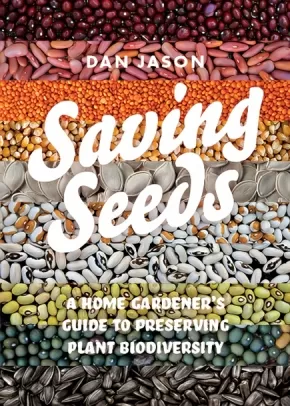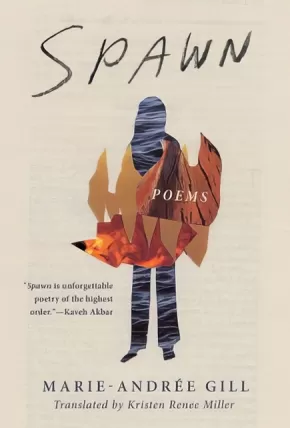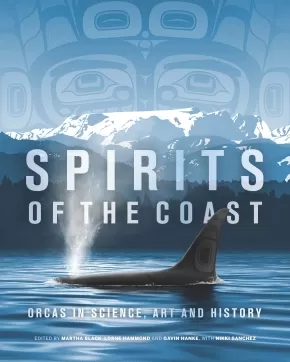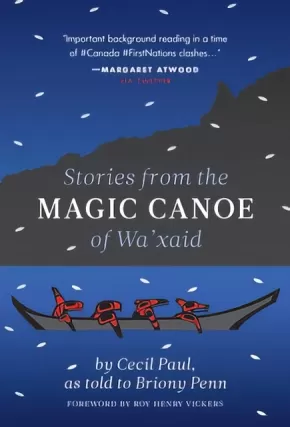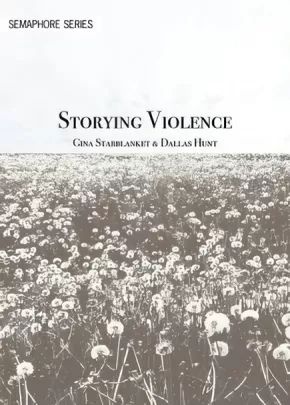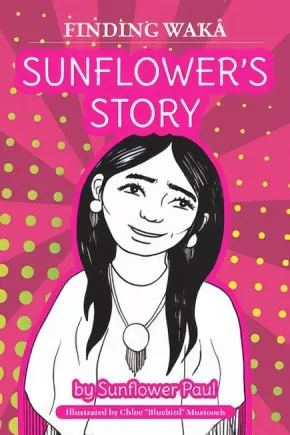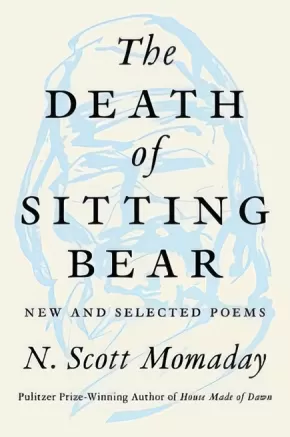
Teen Books
721
-
735
of
1617 Results;
Sort By
Go To
of 108
Red: Un manga haïda
$19.95
Artists:
Format:
Paperback
Text Content Territories:
Indigenous Canadian; First Nations; Haida;
Reading Level: N/A
ISBN / Barcode: 9782925064060
Synopsis:
Synopsis:
Tiré d’un classique de la littérature haïda, ce roman graphique spectaculaire tout couleur nous raconte l’histoire tragique d’un chef autochtone si aveuglé par la revanche qu’il conduit sa communauté vers la guerre et la destruction. Red est le fier chef d’un petit village dans une des îles de la côte nord-ouest de la Colombie-Britannique. Sa soeur qui a été enlevée jadis par des pilleurs est localisée récemment dans un village environnant. Red s’engage à la sauver et à prendre sa revanche sur ses ravisseurs.Le livre comprend 108 pages illustrées et peintes à la main. Il est un métissage adroit entre l’imaginaire haïda et le manga japonais. Cet impressionnant roman d’action graphique sonne l’alarme sur les effets dévastateurs de la rage et de la vengeance.
Educator Information
This book is available in English: Red: A Haida Manga
Additional Information
122 pages | 8.50" x 9.00" | Paperback
Redbone: The True Story of a Native American Rock Band
$25.99
Artists:
Format:
Paperback
Text Content Territories:
Indigenous American; Native American; Shoshone; Indigenous Central American; Indigenous Peoples in Mexico; Yaqui (Yoeme);
ISBN / Barcode: 9781684057146
Synopsis:
Synopsis:
Experience the riveting, powerful story of the Native American civil rights movement and the resulting struggle for identity told through the high-flying career of West Coast rock 'n' roll pioneers Redbone.
You've heard the hit song "Come and Get Your Love" in the movie Guardians of the Galaxy, but the story of the band behind it is one of cultural, political, and social importance.
Brothers Pat and Lolly Vegas were talented Native American rock musicians that took the 1960s Sunset Strip by storm. They influenced The Doors and jammed with Jimmy Hendrix before he was "Jimi," and the idea of a band made up of all Native Americans soon followed. Determined to control their creative vision and maintain their cultural identity, they eventually signed a deal with Epic Records in 1969. But as the American Indian Movement gained momentum the band took a stand, choosing pride in their ancestry over continued commercial reward.
Created in cooperation of the Vegas family, authors Christian Staebler and Sonia Paoloni with artist Thibault Balahy take painstaking steps to ensure the historical accuracy of this important and often overlooked story of America's past. Part biography and part research journalism, Redbone tells a vivid story about this neglected chapter of American history.
Reviews
"Compelling reading for fans of roots rock and Native American history in middle school and up." —School Library Journal
"An entertaining, enlightening history for music fans. Balahy’s loose, energetic drawings; imaginative layouts; and playful use of color make everything pop." —Publishers Weekly
"Musicians with heart put their people before profits in an inspirational tale. Well-researched and well-paced, this book will introduce a new generation to the music and impact of Redbone." —Kirkus Reviews (Starred review)
"In some eyes, the guys in Redbone, still the most successful Native American rock band this country has produced, are indeed superheroes. Not all heroes wear capes, and some wear buckskin." —Houston Chronicle
"In the early sixties, Pat and his brother, Lolly, perform on the Sunset Strip, crossing paths with The Byrds, The Doors, and Jimi Hendrix, who gives the brothers the idea of forming 'an all Indian band. That'd make this country sit up.' The seed germinates and Redbone bursts forth. Staebler and Paoloni offer a lens onto aspects of the twentieth-century Native American struggle for civil rights and injustices like forced schooling and racist policing, as well as the 1968 birth of the American Indian Movement. Balahy's art is particularly splendid and well-varied in style for the complex subject matter." —Booklist
Additional Information
160 pages | 7.00" x 10.00"
Reflections from Them Days: A Residential School Memoir from Nunatsiavut
$12.95
Artists:
Editors:
Format:
Paperback
Text Content Territories:
Indigenous Canadian; Inuit;
ISBN / Barcode: 9781774502075
Synopsis:
Synopsis:
When Nellie Winters was 11 years old, she was sent to attend the Nain Boarding School, a residential school 400 kilometres from her home. In this memoir, she recalls life before residential school, her experiences at the school, and what it was like to come home.
Accompanied by the author’s original illustrations, this moving, often funny memoir sheds light on the experiences of Inuit residential school survivors in Labrador.
Educator & Series Information
Recommended for ages 11-14.
This book is recommended in the Canadian Indigenous Books for Schools 2020/2021 resource list for grades 5 to 7 for English Language Arts and Social Studies.
This book is part of the Qinuisaarniq (“resiliency”) program. This is a program created to educate Nunavummiut about the history and impacts of residential schools, policies of assimilation, and other colonial acts that have affected the Canadian Arctic.
Each resource has been carefully written and reviewed to include level-appropriate opportunities for students to learn about colonial acts and policies that have affected Inuit. These acts and policies created long-lasting impacts on Inuit individuals and communities, which are still being felt today.
The resources in this program include personal interviews, testimony, and writing; non-fiction informational resources; and information about traditional Inuit practices.
Additional Information
26 pages | 9.00" x 7.00" | Transcribed and edited by Erica Oberndorfer
Rougarou
$29.95
Format:
Paperback
Text Content Territories:
Indigenous Canadian; Métis;
Reading Level: N/A
ISBN / Barcode: 9782764626399
Synopsis:
Synopsis:
Joan a le cœur brisé. Voilà plus d’un an qu’elle s’épuise à chercher son mari, Victor, qui a disparu dans la nuit dès leur première dispute, le soir où il a suggéré de vendre à des promoteurs la terre ancestrale qu’elle a héritée de son père. Depuis, elle sillonne les routes de la baie Géorgienne, bien décidée à savoir si Victor est mort ou s’il l’a simplement laissé tomber, comme le pensent sa famille et tout le village métis d’Arcand. Elle croit d’ailleurs l’avoir retrouvé quand, après une soirée trop arrosée, une voix familière l’attire dans une tente d’évangélisation dressée au milieu d’un stationnement, mais l’homme qui apparaît devant elle n’a de Victor que les traits. Pourquoi ne la reconnaît-il pas? Et qui est ce révérend Eugene Wolff dont il dit porter le nom?Aidée de ses deux complices, un adolescent accro à Johnny Cash et une vieille femme aux remarques aussi sages qu’inconvenantes, Joan se mettra alors en quête de rappeler à cet inconnu qui il est vraiment. En chemin, elle découvrira que les histoires de peur de son enfance sont tout sauf des légendes et que, derrière les paroles bienveillantes de la congrégation du révérend Wolff, se cache un projet d’expropriation qui menace une fois encore sa communauté.S’inspirant de la figure du rougarou, cette créature mi-homme mi-loup qui hante l’imaginaire métis, Cherie Dimaline nous offre un roman palpitant, porté par le chagrin et la fureur d’une femme qui refuse d’accepter la perte de ses terres, de ses racines et des siens.« Follement divertissant, profond, essentiel. »Tommy Orange, The New York Times « Un thriller littéraire à lire absolument. »Publishers Weekly
Educator Information
This book is available in English: Empire of Wild
Additional Information
Paperback
Saving Seeds: A Home Gardener's Guide to Preserving Plant Biodiversity
$14.95
Format:
Paperback
ISBN / Barcode: 9781550179002
Synopsis:
Synopsis:
Part garden guide, part manifesto, this is an invitation to preserve our dynamic, sustainable food supply -- one seed at a time.
Much of our food comes from seeds. But where do our seeds come from? And where are they going? For much of human history, farmers saved their own seed stocks to ensure a good harvest from year to year. In the mid-twentieth century, governments became involved in seed saving, creating massive seed libraries cataloguing thousands of varieties. This biodiversity has come under attack in recent decades, as corporations have replaced heirloom varieties with genetic engineering and costly trademarks. In such an agricultural climate, saving seeds becomes both a practical act of preservation and powerful act of protest.
Over half of Canadian households grow fruits, herbs, vegetables or flowers for personal use, according to Statistics Canada. And each of these home gardens has the potential to preserve vital biodiversity, if only we would let plants go to seed, harvest and preserve them. Saving Seeds is a clear and winsome introduction to the essentials of seed saving, from seed selection criteria to harvest and storage tips. It also addresses the role of seed-saving communities: local swaps, seed companies, friends and neighbours and even how the Internet can support this time-honoured practice.
In an era of community gardens, farmers markets and renewed interest in heirloom species, Saving Seeds is a timely call to ensure a more secure future for our seeds and ourselves.
Additional Information
96 pages | 5.00" x 7.00" | b&w illustrations
Spawn
$18.00
Format:
Paperback
Text Content Territories:
Indigenous Canadian; First Nations; Innu (Montagnais-Naskapi); Mashteuiatsh (Pekuakamiulnuatsh);
Grade Levels: 12; University/College;
ISBN / Barcode: 9781771665971
Synopsis:
Synopsis:
Spawn is a braided collection of brief, untitled poems, a coming-of-age lyric set in the Mashteuiatsh Reserve on the shores of Lake Piekuakami (Saint-Jean) in Quebec. Undeniably political, Marie-Andrée Gill's poems ask: How can one reclaim a narrative that has been confiscated and distorted by colonizers?
The poet's young avatar reaches new levels on Nintendo, stays up too late online, wakes to her period on class photo day, and carves her lovers' names into every surface imaginable. Encompassing twenty-first-century imperialism, coercive assimilation, and 90s-kid culture, the collection is threaded with the speaker's desires, her searching: for fresh water to "take the edge off," for a "habitable word," for sex. For her "true north"—her voice and her identity.
Like the life cycle of the ouananiche that frames this collection, the speaker's journey is cyclical; immersed in teenage moments of confusion and life on the reserve, she retraces her scars to let in what light she can, and perhaps in the end discover what to "make of herself".
Reviews
"Spawn is an epic journey that follows the ouananiche in their steadfast ability to hold: rigid, shimmering, hardened to the frigid waters of winter, in all of its capacities of and for whiteness. Here, poems summon a spawn of wonderworking dreams: 'a woman risen up from all these winter worlds, heaped with ice [and] ready to start again'." —Joshua Whitehead, author of Jonny Appleseed
"Spawn is unforgettable poetry of the highest order." —Kaveh Akbar, author of Calling a Wolf a Wolf
"Gill's poems are like small treasures clutched in buried tree roots, preserving 'the chalky veins' of ancestral memory pulsing just below our modern hustle." —Kiki Petrosino, author of White Blood
Educator Information
Recommended in the Canadian Indigenous Books for Schools 2020/2021 resource list for grade 12 for English Language Arts and Social Justice.
Caution: Some foul language, sexual and violent content.
Additional Information
96 pages | 5.25" x 7.75" | Translated by Kristen Renee Miller
Spirits of the Coast: Orcas in Science, Art and History
$29.95
Editors:
Format:
Hardcover
Text Content Territories:
Indigenous Canadian;
ISBN / Barcode: 9780772677686
Synopsis:
Synopsis:
An insightful collection exploring the plight, past and promise of the orca, powerful symbol of BC’s wild coast and apex predator of all oceans. Spirits of the Coast brings together the work of marine biologists, Indigenous knowledge keepers, poets, artists and storytellers, united by their enchantment with the orca. Long feared in Western cultures as “killer whales,” and respected and honoured by Indigenous cultures as friends, family or benefactors, orcas are complex social beings with culture and language of their own. With contributors ranging from Briony Penn to David Suzuki, Gary Geddes and Michael Nicoll Yahgulanaas, this collection brings together diverse voices, young and old, to explore the magic, myths, and ecology of orcas. A literary and visual journey through past and possibility, Spirits of the Coast illustrates how these enigmatic animals have shaped us as much as our actions have impacted them, and provokes the reader to imagine the shape of our shared future.
Educator Information
Includes Indigenous and non-Indigenous contributions.
Recommended in the Canadian Indigenous Books for Schools 2020/2021 resource list for grades 9 to 12 for English Language Arts, Law, Social Studies, Social Justice, Science.
Additional Information
192 pages | 8.00" x 10.00"
Stories from the Magic Canoe of Wa'xaid (PB)
$25.00
Format:
Paperback
Text Content Territories:
Indigenous Canadian; First Nations; Haisla (Kitamaat); Xenaksiala (Henaksiala);
ISBN / Barcode: 9781771603379
Synopsis:
Synopsis:
A remarkable and profound collection of reflections by one of North America’s most important Indigenous leaders.
My name is Wa’xaid, given to me by my people. ‘Wa’ is ‘the river’, ‘Xaid’ is ‘good’ – good river. Sometimes the river is not good. I am a Xenaksiala, I am from the Killer Whale Clan. I would like to walk with you in Xenaksiala lands. Where I will take you is the place of my birth. They call it the Kitlope. It is called Xesdu’wäxw (Huschduwaschdu) for ‘blue, milky, glacial water’. Our destination is what I would like to talk about, and a boat – I call it my magic canoe. It is a magical canoe because there is room for everyone who wants to come into it to paddle together. The currents against it are very strong but I believe we can reach that destination and this is the reason for our survival. —Cecil Paul
Who better to tell the narrative of our times about the restoration of land and culture than Wa’xaid (the good river), or Cecil Paul, a Xenaksiala elder who pursued both in his ancestral home, the Kitlope — now the largest protected unlogged temperate rainforest left on the planet. Paul’s cultural teachings are more relevant today than ever in the face of environmental threats, climate change and social unrest, while his personal stories of loss from residential schools, industrialization and theft of cultural property (the world-renowned Gps’golox pole) put a human face to the survivors of this particular brand of genocide.
Told in Cecil Paul’s singular, vernacular voice, Stories from the Magic Canoe spans a lifetime of experience, suffering and survival. This beautifully produced volume is in Cecil’s own words, as told to Briony Penn and other friends, and has been meticulously transcribed. Along with Penn’s biography of Cecil Paul, Following the Good River, Stories from the Magic Canoe provides a valuable documented history of a generation that continues to deal with the impacts of brutal colonization and environmental change at the hands of politicians, industrialists and those who willingly ignore the power of ancestral lands and traditional knowledge.
Reviews
“The Magic Canoe brings peace to one’s soul. It is a warm wind moving our hearts. Wa’xaid takes us on a journey that regenerates and empowers us. T’ismista, the stone hunter, looks down on the Magic Canoe and reminds us to listen to storytellers like Cecil Paul. This is a story for the family of man; we are all in the canoe together and our stories need to be shared with each other.” – Roy Henry Vickers
Educator Information
Recommended in the Canadian Indigenous Books for Schools 2019-2020 resource list, as well as the 2020-2021 resource list, for grades 9 to 12 for English Language Arts, Social Studies, and Science.
Additional Information
224 pages | 5.00" x 7.00" | Paperback
Storying Violence: Unravelling Colonial Narratives in the Stanley Trial
$15.00
Format:
Paperback
Text Content Territories:
Indigenous Canadian; First Nations; Cree (Nehiyawak);
Reading Level: N/A
ISBN / Barcode: 9781927886373
Synopsis:
Synopsis:
In August of 2016, Cree youth Colten Boushie was shot dead by Saskatchewan farmer Gerald Stanley. Using colonial and socio-political narratives that underlie white rural settler life, the authors position the death of Boushie and trial of Stanley in relation to Indigenous histories and experiences in Saskatchewan. They point to the Stanley case as just one instance of Indigenous peoples' presence being seen as a threat to settler-colonial security, then used to sanction the exclusion, violent treatment, and death of Indigenous peoples and communities.
Additional Information
120 pages | 5.00" x 7.00"
Sunflower's Story
$10.95
Format:
Paperback
Text Content Territories:
Indigenous Canadian;
ISBN / Barcode: 9781926696843
Synopsis:
Synopsis:
A personal account of a young Indigenous girl who experiences intolerance, a sense of not belonging and family struggles. She learns from her grandfather the traditional ways of ceremony and fasting to go beyond the needs of the body to where she begins to know her higher self.
Educator & Series Information
Recommended for ages 13 to 18.
This book is part of the Finding Waka series.
Keywords / Themes: Acceptance, Anxiety, Ceremony, Family, Fasting, Growth, Healing, Spirituality, Racism, Intolerance.
Additional Information
52 pages | 6.00" x 9.00" | Paperback
The Barren Grounds (PB)
$12.99
Format:
Paperback
Text Content Territories:
Indigenous Canadian; First Nations; Cree (Nehiyawak); Swampy Cree ;
ISBN / Barcode: 9780735266124
Synopsis:
Synopsis:
Narnia meets traditional Indigenous stories of the sky and constellations in an epic middle-grade fantasy series from award-winning author David Robertson.
Morgan and Eli, two Indigenous children forced away from their families and communities, are brought together in a foster home in Winnipeg, Manitoba. They each feel disconnected, from their culture and each other, and struggle to fit in at school and at their new home -- until they find a secret place, walled off in an unfinished attic bedroom. A portal opens to another reality, Askí, bringing them onto frozen, barren grounds, where they meet Ochek (Fisher). The only hunter supporting his starving community, Misewa, Ochek welcomes the human children, teaching them traditional ways to survive. But as the need for food becomes desperate, they embark on a dangerous mission. Accompanied by Arik, a sassy Squirrel they catch stealing from the trapline, they try to save Misewa before the icy grip of winter freezes everything -- including them.
Reviews
"David A. Robertson has written such a fine, beautiful novel. He manages to combine hard truths about our history with a Narnia-like fantasy, sweeping us into the world of the story while opening our hearts as well." -- Susin Nielsen, author of We Are All Made of Molecules and No Fixed Address
“This is a book that is rich in its characterization, evocative in its descriptions, and skillful in its weaving together of traditions of the past and life in the present.” --CM Magazine
"This middle-grade fantasy deftly and compellingly centers Indigenous culture." --STARRED REVIEW, Kirkus Reviews
"The Barren Grounds: The Misewa Saga is a story about two Indigenous children forced away from their families to a foster home in Winnipeg, Manitoba. Struggling to fit, the two children find a space in the attic that opens a portal into another realm. They learn the traditional ways to survive and embark on a dangerous mission there." - The Dalai Lama Center
Educator & Series Information
For ages 10+ (middle-grades).
This is Book 1 of the Misewa Saga. Narnia meets traditional Indigenous stories of the sky and constellations in this epic middle-grade fantasy series from award-winning author David Robertson.
This book is available in French: La saga Misewa: N° 1 - Les terres isolées.
Additional Information
256 pages | 5.44" x 8.25" | Jacket art and interior illustrations Natasha Donovan | Paperback
The Case of the Missing Auntie
$11.95
Format:
Paperback
Text Content Territories:
Indigenous Canadian; First Nations; Cree (Nehiyawak);
ISBN / Barcode: 9781772601176
Synopsis:
Synopsis:
In the bright lights of the big city, the Mighty Muskrats search for an auntie lost long ago.
The Mighty Muskrats are off to the city to have fun at the Exhibition Fair. But when Chickadee asks Grandpa what he would like them to bring back from the city, she learns about Grandpa’s missing little sister. She was, they learn, “scooped” years ago – like many Indigenous children, the government had arranged for her adoption by strangers without her parents’ permission. Now, the Mighty Muskrats have a new case to solve: to find the whereabouts of their grandpa’s long-lost sister. Once in the bright lights of the big city, the cousins get distracted, face off with bullies, meet some heroes and unlikely teachers, and experience many of the difficulties First Nations kids can face in the city. The Muskrats’ search for their missing auntie takes them all the way to the government, and reveals hard truths about their country’s treatment of First Nations kids and families.
Reviews
"The Case of the Missing Auntie is the second book in the Mighty Muskrats Mystery series and features the group visiting an Exhibition fair in the city. The Muskrats find their next mystery to solve when Chickadee learns that Grandpa’s missing sister was adopted without permission many years ago." - The Dalai Lama Center
Educator & Series Information
This is Book 2 in the Mighty Muskrats Mystery Series. Following The Case of Windy Lake, this second edition to the series follows these young sleuths as they explore the history of residential schools and the "scoops" that saw Canada take Indigenous children from their families and adopt them out to strangers.
This book introduces young people to the history of Sixties Scoop in North America and how thousands of Indigenous children were taken from their families and given to white families to be raised.
This book tells of a classic fish-out-of-water experience as the kids try and figure out the nuances of the big city.
Recommended for ages 9 to 12.
Guided Reading: V
Lexile: 670L
This book is available in French: Sur les traces de tante Charlotte: Une enquête des Rats musclés
Additional Information
192 pages | 5.25" x 7.50"
The Death of Sitting Bear: New and Selected Poems
$35.99
Format:
Hardcover
Text Content Territories:
Indigenous American; Native American; Kiowa;
ISBN / Barcode: 9780062961150
Synopsis:
Synopsis:
Pulitzer Prize winner and celebrated American master N. Scott Momaday returns with a radiant collection of more than 200 new and selected poems rooted in Native American tradition.
“The poems in this book reflect my deep respect for and appreciation of words. . . . I believe that poetry is the highest form of verbal expression. Although I have written in other forms, I find that poems are what I want and need most to read and write. They give life to my mind.”
One of the most important and unique voices in American letters, distinguished poet, novelist, artist, teacher, and storyteller N. Scott Momaday was born into the Kiowa tribe and grew up on Indian reservations in the Southwest. The customs and traditions that influenced his upbringing—most notably the Native American oral tradition—are the centerpiece of his work.
This luminous collection demonstrates Momaday’s mastery and love of language and the matters closest to his heart. To Momaday, words are sacred; language is power. Spanning nearly fifty years, the poems gathered here illuminate the human condition, Momaday’s connection to his Kiowa roots, and his spiritual relationship to the American landscape.
The title poem, “The Death of Sitting Bear” is a celebration of heritage and a memorial to the great Kiowa warrior and chief. “I feel his presence close by in my blood and imagination,” Momaday writes, “and I sing him an honor song.” Here, too, are meditations on mortality, love, and loss, as well as reflections on the incomparable and holy landscape of the Southwest.
The Death of Sitting Bear evokes the essence of human experience and speaks to us all.
Reviews
“These are the poems of a master poet, born of an age when our ears were not so bent towards digital production. Or should I say, these are the poems of a bear who has walked through several generations and stands before us, breathing clouds into a cold dawn, bearing this book of poetry. The bear’s journey is mythic, a migration through tragedy and beauty, over lands rich with horses and stories. When you read these poems, you will learn to hear deeply the sound a soul makes as it sings about the mystery of dreaming and becoming.”— Joy Harjo, Mvskoke Nation, U.S. Poet Laureate
"An admirable capstone to a distinguished literary career, this splendid selection should be a treasure for Momaday’s readers and an excellent introduction for those new to Native American writing."— Library Journal (starred review)
Additional Information
192 pages | 6.00" x 9.00"
The Eagle Mother
$23.00
Artists:
Format:
Hardcover
Text Content Territories:
Indigenous Canadian; First Nations; Gitxsan (Gitksan);
ISBN / Barcode: 9781553798590
Synopsis:
Synopsis:
Return to the valleys of the River of Mists with award-winning author Hetxw'ms Gyetxw (Brett D. Huson). Nox xsgyaak, the eagle mother, cares for her brood in the embrace of a black cottonwood with the help of her mate. Will both eaglets survive the summer in an environment that is both delicate and unforgiving?
Learn about the life cycle of these stunning birds of prey, the traditions of the Gitxsan, and how bald eagles can enrich their entire ecosystem. Evocative illustration brings the Xsan's flora and fauna to life for middle years readers in book three of the Mothers of Xsan series.
Reviews
“The Eagle Mother by Hetxw’ms Gyetxw (Brett D. Huson) and illustrator Natasha Donovan, the third in the Mothers of Xsan series, which offers a perspective on the life cycle of animals important to the land and to people.”— Publishers Weekly
"For further learning about the Gitxsan, the author has included a glossary titled "The Gitxsan Moons" and a summary of Gitxsan Nation clans" - Canadian Indigenous Books for Schools 2020/2021
Educator & Series Information
Recommended ages: 9 to 12 (Grades 3 to 7).
This is the third book in the Mothers of Xsan series, which uses striking illustration and lyrical language to bring the poetry of the Xsan ecosystem to life. The traditional Gitxsan formline art and language weave together throughout the stories in this series to paint a vivid picture of the Gitxsan people.
The Mothers of Xsan series is a collection of stories that connect the world to the matrilineal society of the Gitxsan people, located in Northwestern British Columbia. It presents scientific knowledge in language and a format that is accessible. Each book in the series showcases the depth and importance of the knowledge that has been gathered and shared through this unique style of storytelling. The stories of life cycle, connection the land and language are told from the perspective of the Mothers of Xsan system's animals.
Recommended in the Canadian Indigenous Books for Schools 2020/2021 resource list as being useful for grades 1-4 in the areas of Language Arts, Science, and Social Studies.
Additional Information
32 pages | 6.50" x 10.00"
The East Side of It All
$19.95
Format:
Paperback
Text Content Territories:
Indigenous Canadian; First Nations; Salish; Coast Salish; Sto:lo; Kwantlen;
Grade Levels: University/College;
ISBN / Barcode: 9780889713802
Synopsis:
Synopsis:
The East Side of It All draws on Joseph Dandurand’s first-hand experiences of life as a drug user and single-room occupant in Vancouver’s Downtown Eastside, and of the ongoing process of healing through reconnection with family, the natural world and traditional Indigenous (Kwantlen) storytelling. His voice is lyrical yet intimate, obscured yet sitting with you at the kitchen table having a cigarette. The East Side of It All is the journey of a broken man who finally accepts his storytelling gift and shares with the world his misery, joy and laughter.
Additional Information
96 pages | 5.50" x 8.00"
Sort By
Go To
of 108







